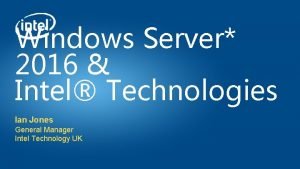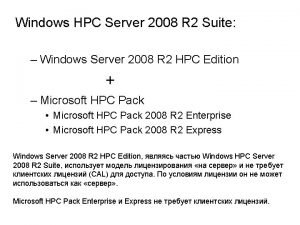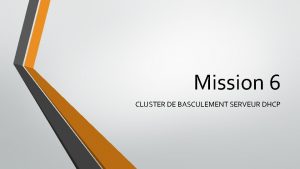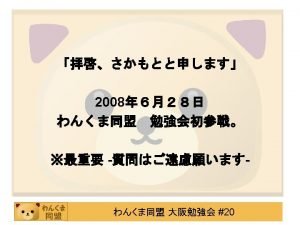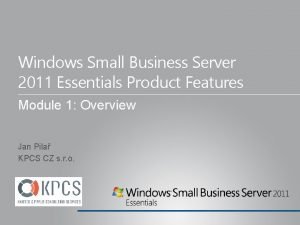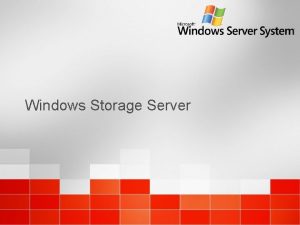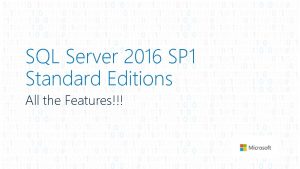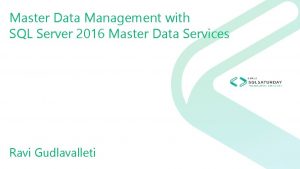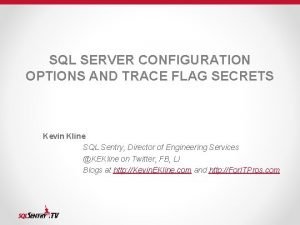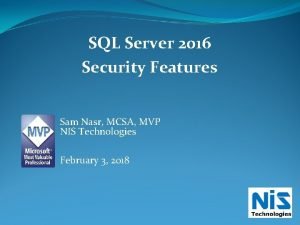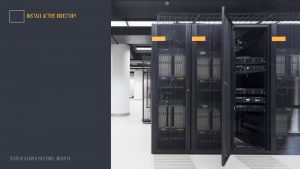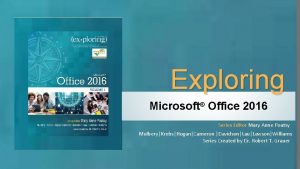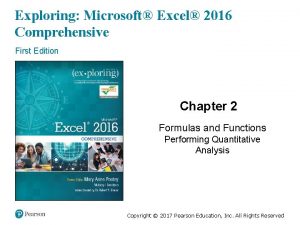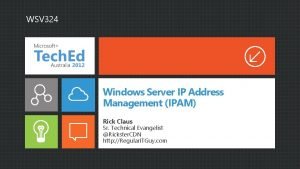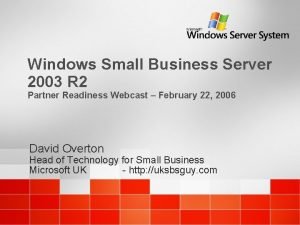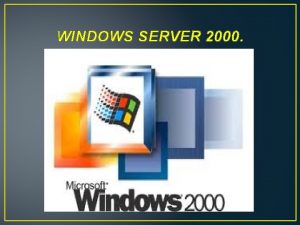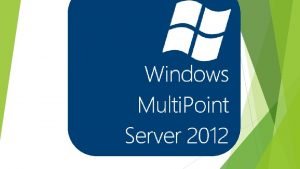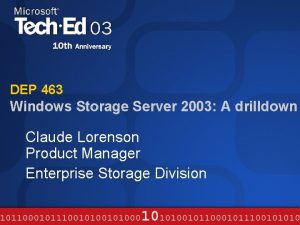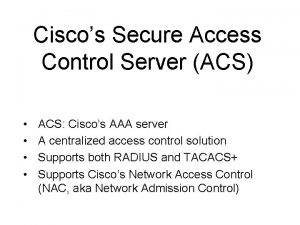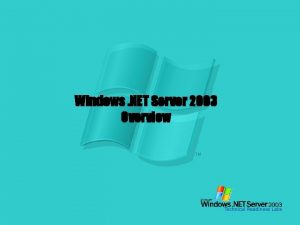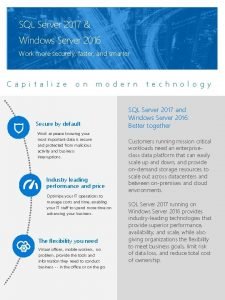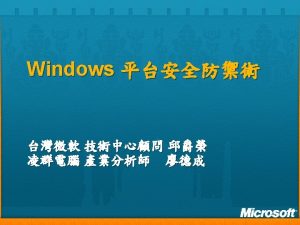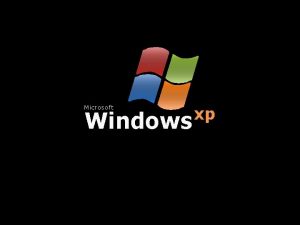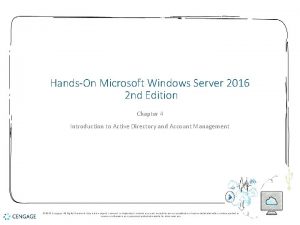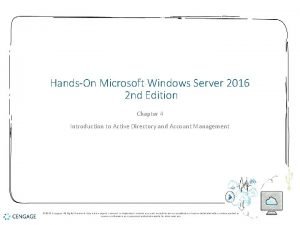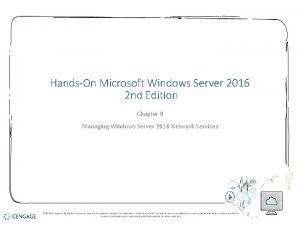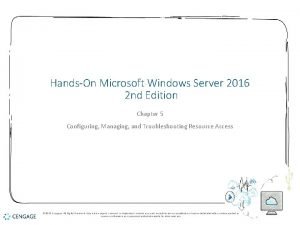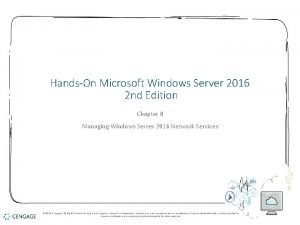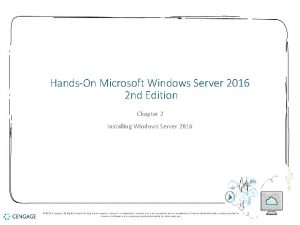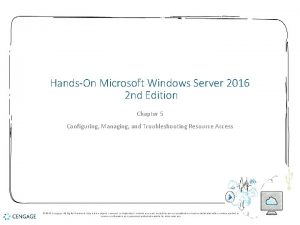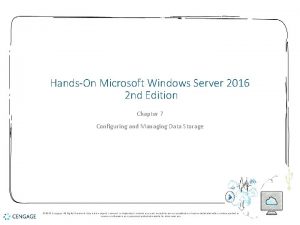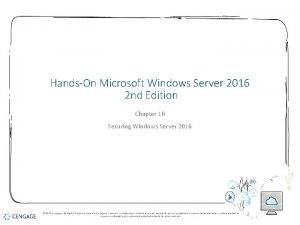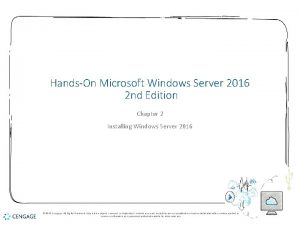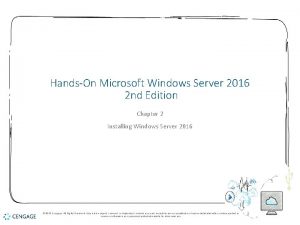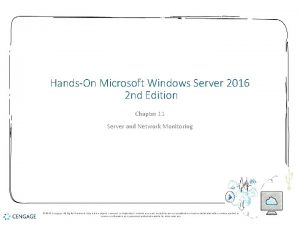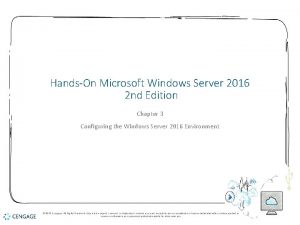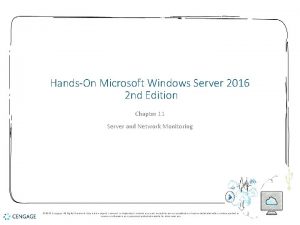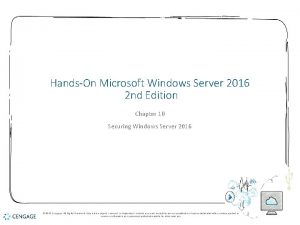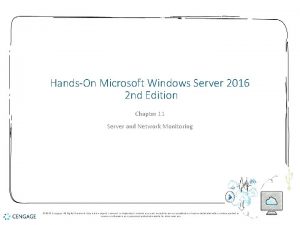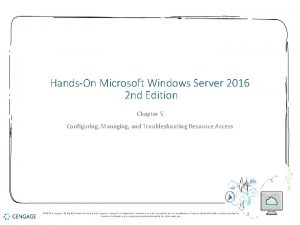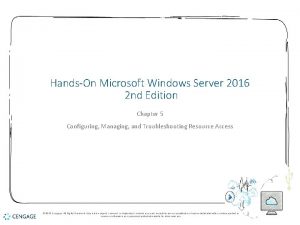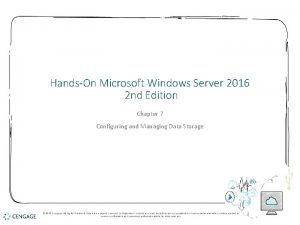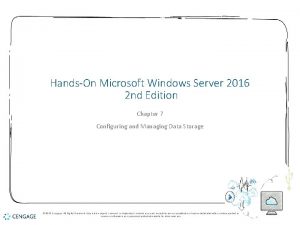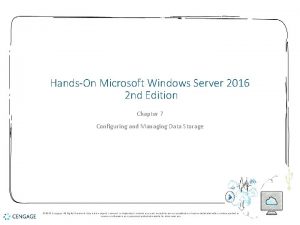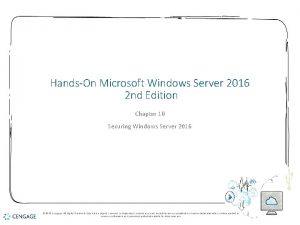HandsOn Microsoft Windows Server 2016 2 nd Edition
















































- Slides: 48

Hands-On Microsoft Windows Server 2016 2 nd Edition Chapter 6 Configuring Windows Server 2016 Printing © 2018 Cengage. All Rights Reserved. May not be copied, scanned, or duplicated, in whole or in part, except for use as permitted in a license distributed with a certain product or service or otherwise on a password-protected website for classroom use.

Objectives Understand how Windows Server 2016 printing works on a network and on the Internet Understand apply the Print and Document Services role Use the XPS Print Path Use the Print Management tool to configure network printing resources Install local and shared printers Configure printer properties Configure a network or Internet printer Manage print jobs Troubleshoot common printing problems © 2018 Cengage. May not be copied, scanned, or duplicated, in whole or in part, except for use as permitted in a license distributed with a certain product or service or otherwise on a passwordprotected website for classroom use.

An Overview of Windows Server 2016 Printing • Network printing process components • • • Local print device Network print device Print client Print server Print job Printer driver • Spooling • Frees the server CPU to handle other processing requests in addition to print requests © 2018 Cengage. All Rights Reserved. May not be copied, scanned, or duplicated, in whole or in part, except for use as permitted in a license distributed with a certain product or service or otherwise on a password-protected website for classroom use. 3

How Network Printing Works • Printing process steps • • Application at the client generates a print file Application communicates with the Windows graphics device interface (GDI) When the GDI is finished, the print file is formatted with control codes The remote print provider at the client makes a remote procedure call to the network print server The network print server uses four processes to receive and process a print file: router, print provider, print processor, and print monitor The Server service calls its router, the Print Spooler service While the file is spooled, the print provider works with the print processor to ensure that the file is formatted to use the right data type The print monitor pulls it from the spooler’s disk storage and sends it off to the printer © 2018 Cengage. All Rights Reserved. May not be copied, scanned, or duplicated, in whole or in part, except for use as permitted in a license distributed with a certain product or service or otherwise on a password-protected website for classroom use. 4

How Internet Printing Works (1 of 2) • When a Windows client wants to process a print job through the Internet • The client must have Internet Printing Client installed • Internet Printing Client should be installed in Windows Server 2016 • So client and server can communicate using a common protocol • Windows Server 2016 can be configured to act as a web-based print server by having the following elements: • Internet Printing Client • Print and Document Services role with the Internet Printing role service installed • Web Server role (IIS; Internet Information Services) © 2018 Cengage. All Rights Reserved. May not be copied, scanned, or duplicated, in whole or in part, except for use as permitted in a license distributed with a certain product or service or otherwise on a password-protected website for classroom use. 5

How Internet Printing Works (2 of 2) • The print process on the client is nearly the same as for network printing with a couple of exceptions: • The browser sends the print file to the GDI (instead of client application) • Remote print provider at the client makes a remote procedure call to IIS on the Windows 2016 server - The remote procedure call is made through TCP/IP-based HTTP, which transports another protocol, called the Internet Printing Protocol (IPP) • IPP • Is facilitated through the Internet Printing Client on the client requesting the print job and the Windows Server 2016 server • IPP encapsulates the remote procedure call and print process information and is transported in HTTP © 2018 Cengage. All Rights Reserved. May not be copied, scanned, or duplicated, in whole or in part, except for use as permitted in a license distributed with a certain product or service or otherwise on a password-protected website for classroom use. 6

The Print and Document Services Role (1 of 2) • Print and Document Services role • Enables you to set up Windows Server 2016 as a print server to coordinate and manage network and Internet printing functions • Advantage of the role: • You can configure a Group Policy for standardized management of printer resources • Print Management Tool enables you to: • Manage shared printers • Track printing events through a log you can view using Event Viewer © 2018 Cengage. All Rights Reserved. May not be copied, scanned, or duplicated, in whole or in part, except for use as permitted in a license distributed with a certain product or service or otherwise on a password-protected website for classroom use. 7

The Print and Document Services Role (2 of 2) • Role services available within the Print and Document Services role: • Printer Server – turns the server into a print server and installs the Print Management tool • Distributed Scan Server – enables Windows Server 2016 to receive scanned documents from network scanners and deliver them to designated server clients • Internet Printing – creates a website through IIS for Internet printing, managing print jobs, and for connecting to shared printers using IPP through Internet Printing Client • LPD Service – Line Printer Daemon (LPD) enables UNIX and Linux computers to print to shared printers managed through Windows Server 2016 © 2018 Cengage. All Rights Reserved. May not be copied, scanned, or duplicated, in whole or in part, except for use as permitted in a license distributed with a certain product or service or otherwise on a password-protected website for classroom use. 8

Using the XPS Print Path (1 of 2) • XML Paper Specification (XPS) • An advanced way of printing documents for multiple purposes, including viewing electronic pages and printing pages in a polished format • XPS is a concept similar to using PDF files • The XPS print path in Windows Server 2016 is offered as an alternative to the GDI print path • Used by conventional documents © 2018 Cengage. All Rights Reserved. May not be copied, scanned, or duplicated, in whole or in part, except for use as permitted in a license distributed with a certain product or service or otherwise on a password-protected website for classroom use. 9

Using the XPS Print Path (2 of 2) • XPS enhancements • • Customized print path for documents using XPS Advanced color support for sophisticated color printers Faster performance for printouts generated by. NET Framework applications Full WYSIWYG (What You See Is What You Get) • The XPS drive path uses the XPSDrv Driver Model • This driver can print to an XPS-enabled printer or a file • Windows Server 2016 has XPS services built into the Print and Document Services role © 2018 Cengage. All Rights Reserved. May not be copied, scanned, or duplicated, in whole or in part, except for use as permitted in a license distributed with a certain product or service or otherwise on a password-protected website for classroom use. 10

The Devices and Printers Utility (1 of 2) • Windows Server 2016 Devices and Printers utility • A tool you can use to configure printing resources • Enables you to set up a printer directly connected to a server, set up a network printer, and set up a printer through Bluetooth • The Devices and Printers utility is started from Control Panel • An alternate way to set up and manage printers is to use the Print Management Tool © 2018 Cengage. All Rights Reserved. May not be copied, scanned, or duplicated, in whole or in part, except for use as permitted in a license distributed with a certain product or service or otherwise on a password-protected website for classroom use. 11

The Devices and Printers Utility (2 of 2) © 2018 Cengage. All Rights Reserved. May not be copied, scanned, or duplicated, in whole or in part, except for use as permitted in a license distributed with a certain product or service or otherwise on a password-protected website for classroom use. 12

Using the Print Management Tool (1 of 2) • The Print Management tool • Also available as an MMC snap-in • Centralizes local and shared printer control in one place • Enables printer administrators and operators to manage the print functions of some or all of the shared printers on a network • Using the Print Management tool, you can: • Install and configure local and network printers • Configure printer properties, sharing, and security • You can open this tool from: • The Server Manager Tools menu • The MMC • The Start button by clicking the Windows Administrative Tools folder and Print Management © 2018 Cengage. All Rights Reserved. May not be copied, scanned, or duplicated, in whole or in part, except for use as permitted in a license distributed with a certain product or service or otherwise on a password-protected website for classroom use. 13

Using the Print Management Tool (2 of 2) © 2018 Cengage. All Rights Reserved. May not be copied, scanned, or duplicated, in whole or in part, except for use as permitted in a license distributed with a certain product or service or otherwise on a password-protected website for classroom use. 14

Configuring the Print Server Properties • Using the Print Management tool you can: • • • Set up the forms to use Configure print spooler properties Configure security to apply to all printers managed by the print server View installed printer driver information for all printers Update a specific printer driver Accomplish other tasks • Activity 6 -4 enables you to see how to configure the print server properties © 2018 Cengage. All Rights Reserved. May not be copied, scanned, or duplicated, in whole or in part, except for use as permitted in a license distributed with a certain product or service or otherwise on a password-protected website for classroom use. 15

Installing Local and Shared Printers (1 of 3) • In Windows Server 2016, you can configure a printer that is attached to the server computer as a local printer • And then enable it as a shared printer • You can also configure a network printer as a shared printer managed through a Windows Server 2016 print server • The steps for installing a local printer depend on the type of printer you are adding • If a printer is not automatically detected through Plug and Play, you can use the Network Printer Installation Wizard to install it • Activity 6 -5 shows you how to install a printer using the Network Printer Installation Wizard © 2018 Cengage. All Rights Reserved. May not be copied, scanned, or duplicated, in whole or in part, except for use as permitted in a license distributed with a certain product or service or otherwise on a password-protected website for classroom use. 16

Installing Local and Shared Printers (2 of 3) © 2018 Cengage. All Rights Reserved. May not be copied, scanned, or duplicated, in whole or in part, except for use as permitted in a license distributed with a certain product or service or otherwise on a password-protected website for classroom use. 17

Installing Local and Shared Printers (3 of 3) • When you add a shared printer, consider the following guidelines when choosing a share name: • Compose names that are easily understood and spelled by those who will use the printer • Include a room number, floor, or workstation name to identify where the printer is located • Include descriptive information about the printer, such as type, manufacturer, or model • After you install a printer on a network to be shared • Make sure that network printer sharing is turned on © 2018 Cengage. All Rights Reserved. May not be copied, scanned, or duplicated, in whole or in part, except for use as permitted in a license distributed with a certain product or service or otherwise on a password-protected website for classroom use. 18

Configuring Printer Properties • Printer properties are accessible from the Print Management tool by rightclicking a printer and clicking Properties • You can manage the following functions associated with a printer from the tabs in the Properties dialog box: • • General printer information Printer sharing Printer port setup Printer availability and advanced spooling options Security Device settings Special considerations of a specific printer © 2018 Cengage. All Rights Reserved. May not be copied, scanned, or duplicated, in whole or in part, except for use as permitted in a license distributed with a certain product or service or otherwise on a password-protected website for classroom use. 19

General Printer Specifications © 2018 Cengage. All Rights Reserved. May not be copied, scanned, or duplicated, in whole or in part, except for use as permitted in a license distributed with a certain product or service or otherwise on a password-protected website for classroom use. 20

Sharing Printers (1 of 2) • The Sharing tab is used to enable or disable a printer for sharing • As well as to specify the name of the share • If you enable sharing, provide a name for the shared printer • And check List in the directory to publish the printer through Active Directory • The Additional Drivers button on a printer’s properties Sharing tab is used to add new types of clients • Windows Server 2016 enables use of Point and Print with the v 4 driver model • This means Windows Server 2016 print server does not have to distribute specific drivers to clients updated with v 4 printer drivers © 2018 Cengage. All Rights Reserved. May not be copied, scanned, or duplicated, in whole or in part, except for use as permitted in a license distributed with a certain product or service or otherwise on a password-protected website for classroom use. 21

Sharing Printers (2 of 2) © 2018 Cengage. All Rights Reserved. May not be copied, scanned, or duplicated, in whole or in part, except for use as permitted in a license distributed with a certain product or service or otherwise on a password-protected website for classroom use. 22

Port Specifications (1 of 4) • The Ports tab has options to: • Specify which server port, such as LPT 1 or COM 1, is used for the printer • Set up bidirectional printing and printer pooling • Bidirectional printing • Used with printers that have bidirectional capability • A bidirectional printer can engage in two-way communications with the print server and with software applications • Printer pooling • Involves configuring two or more identical printers connected to one print server • All of the printers in a pool must be identical so that they use the same printer driver and handle print files in the same way © 2018 Cengage. All Rights Reserved. May not be copied, scanned, or duplicated, in whole or in part, except for use as permitted in a license distributed with a certain product or service or otherwise on a password-protected website for classroom use. 23

Port Specifications (2 of 4) © 2018 Cengage. All Rights Reserved. May not be copied, scanned, or duplicated, in whole or in part, except for use as permitted in a license distributed with a certain product or service or otherwise on a password-protected website for classroom use. 24

Port Specifications (3 of 4) • The Add Port button enables you to add a new port • The default options are Local Port or Standard TCP/IP Port • The Delete Port button is used to remove a port option from the list of ports • The Configure Port button is used to tune the configuration parameters that are appropriate to the type of port © 2018 Cengage. All Rights Reserved. May not be copied, scanned, or duplicated, in whole or in part, except for use as permitted in a license distributed with a certain product or service or otherwise on a password-protected website for classroom use. 25

Port Specifications (4 of 4) © 2018 Cengage. All Rights Reserved. May not be copied, scanned, or duplicated, in whole or in part, except for use as permitted in a license distributed with a certain product or service or otherwise on a password-protected website for classroom use. 26

Printer Scheduling and Advanced Options (1 of 5) • The Advanced tab allows you to: • Have a printer available at all times • Limit the time to a range of hours • You can set the priority higher to give a particular printer or printer pool priority • Over other printers attached to the server • Printer scheduling can be useful when there is one print device and two printer objects (shares) for that printer © 2018 Cengage. All Rights Reserved. May not be copied, scanned, or duplicated, in whole or in part, except for use as permitted in a license distributed with a certain product or service or otherwise on a password-protected website for classroom use. 27

Printer Scheduling and Advanced Options (2 of 5) © 2018 Cengage. All Rights Reserved. May not be copied, scanned, or duplicated, in whole or in part, except for use as permitted in a license distributed with a certain product or service or otherwise on a password-protected website for classroom use. 28

Printer Scheduling and Advanced Options (3 of 5) • The Advanced tab provides the option to use spooled printing or to bypass the spooler • Works best to spool print jobs so they are printed on a first-come, first-served basis and enable background printing so the CPU can work on other tasks • Also helps ensure that jobs are printed together • Other advanced options include: • • Hold mismatched documents Print spooled documents first Keep printed documents Enable advanced printing features © 2018 Cengage. All Rights Reserved. May not be copied, scanned, or duplicated, in whole or in part, except for use as permitted in a license distributed with a certain product or service or otherwise on a password-protected website for classroom use. 29

Printer Scheduling and Advanced Options (4 of 5) • The Printing Defaults button enables you to specify default settings for print jobs • Unless they are overridden by control codes in the print file • Use the Print Processor button to specify one of the print processors and data types • The data type is the way in which information is formatted in a print file • • • RAW (FF appended) RAW (FF auto) NT EMF TEXT XPS 2 GDI © 2018 Cengage. All Rights Reserved. May not be copied, scanned, or duplicated, in whole or in part, except for use as permitted in a license distributed with a certain product or service or otherwise on a password-protected website for classroom use. 30

Printer Scheduling and Advanced Options (5 of 5_ • The Separator Page button is used to place a blank page at the beginning of each printed document • Windows Server 2016 has four separator page files • • Pcl. sep Pscript. sep Sysprint. sep Sysprtj. sep © 2018 Cengage. All Rights Reserved. May not be copied, scanned, or duplicated, in whole or in part, except for use as permitted in a license distributed with a certain product or service or otherwise on a password-protected website for classroom use. 31

Configuring Security (1 of 4) • To configure security for a printer, you must have Manage printers permissions for that printer • Use the Security tab to set up printer share permissions • Once a printer is shared, the default permissions are as follows: • • • Everyone group-Print ALL APPLICATION PACKAGES-Print and Manage documents CREATOR OWNER-Manage documents Administrator account-Print, Manage this printer, and Manage documents Administrators, Server Operators, Print Operators groups-Print, Manage this printer, and Manage documents © 2018 Cengage. All Rights Reserved. May not be copied, scanned, or duplicated, in whole or in part, except for use as permitted in a license distributed with a certain product or service or otherwise on a password-protected website for classroom use. 32

Configuring Security (2 of 4) © 2018 Cengage. All Rights Reserved. May not be copied, scanned, or duplicated, in whole or in part, except for use as permitted in a license distributed with a certain product or service or otherwise on a password-protected website for classroom use. 33

Configuring Security (3 of 4) • Use the Advanced button on the Security tab to: • • • Set up special printer permissions for a specific group or user Add or remove a group or user for security access Set up printer auditing Take ownership of a printer View the effective permissions for a user or group • Advanced or special access permissions enable you to fine-tune shared printer permissions • Any user account or group can be set up for auditing, by clicking the Auditing tab and the Add button • Before you set up printer auditing, make sure that there is a Group Policy or default domain security policy that enables object auditing on the basis of successful and failed activity attempts © 2018 Cengage. All Rights Reserved. May not be copied, scanned, or duplicated, in whole or in part, except for use as permitted in a license distributed with a certain product or service or otherwise on a password-protected website for classroom use. 34

Configuring Security (4 of 4) • For a shared printer you can track successful or failed attempts to: • • • Print jobs Manage printers Manage documents Read printer share permissions Change printer share permissions Take ownership of the printer © 2018 Cengage. All Rights Reserved. May not be copied, scanned, or duplicated, in whole or in part, except for use as permitted in a license distributed with a certain product or service or otherwise on a password-protected website for classroom use. 35

Configuring Device Settings (1 of 2) • The Device Settings tab • Enables you to specify printer settings that are specific to the printer you have installed such as: - Printer trays, memory, paper size, fonts, duplexing, and installable options • Printer memory is usually automatically detected in bidirectional printers • Make sure the memory reported in the device settings matches the memory installed in the printer • This enables the Windows Server 2016 print server to offload more work to the printer, improving the speed at which print jobs are completed as well as server performance © 2018 Cengage. All Rights Reserved. May not be copied, scanned, or duplicated, in whole or in part, except for use as permitted in a license distributed with a certain product or service or otherwise on a password-protected website for classroom use. 36

Configuring Device Settings (2 of 2) © 2018 Cengage. All Rights Reserved. May not be copied, scanned, or duplicated, in whole or in part, except for use as permitted in a license distributed with a certain product or service or otherwise on a password-protected website for classroom use. 37

Configuring a Nonlocal Printer or an Internet Printer (1 of 2) • You can connect to a network printer by using the Network Printer Installation Wizard • Follow the steps outlined on pages 271 -272 in the text • When the remote printer is installed on a domain controller • You can change the properties of the shared printer you just installed • Even though you are not logged on to its host computer • You can manage the remote printer’s properties from the Print Management tool © 2018 Cengage. All Rights Reserved. May not be copied, scanned, or duplicated, in whole or in part, except for use as permitted in a license distributed with a certain product or service or otherwise on a password-protected website for classroom use. 38

Configuring a Nonlocal Printer or an Internet Printer (2 of 2) © 2018 Cengage. All Rights Reserved. May not be copied, scanned, or duplicated, in whole or in part, except for use as permitted in a license distributed with a certain product or service or otherwise on a password-protected website for classroom use. 39

Managing Print Jobs • Users with Print permissions can: • Send print jobs to the printer • Pause, resume, and restart their own print jobs • Cancel their own print jobs • Print Operators, Server Operators, and other groups having Manage documents permissions can: • Send print jobs to the printer • Pause, resume, and restart any user’s print jobs • Cancel any user’s print jobs • To manage printed documents as administrator • Use the Print Management tool © 2018 Cengage. All Rights Reserved. May not be copied, scanned, or duplicated, in whole or in part, except for use as permitted in a license distributed with a certain product or service or otherwise on a password-protected website for classroom use. 40

Controlling the Status of Printing (1 of 2) • In Windows Server 2016, printer control and setup information for a particular printer is associated with that printer’s properties and the printer’s print queue • Sometimes you need to pause a printer to fix a problem • You can pause printing to that printer in two way: • Right-click the printer in the middle pane of the Print Management tool and click Pause Printing • Open the printer’s print queue window, click Printer, and click Pause Printing option so that there is a check mark beside it • You will need to resume printing again before print jobs can continue printing © 2018 Cengage. All Rights Reserved. May not be copied, scanned, or duplicated, in whole or in part, except for use as permitted in a license distributed with a certain product or service or otherwise on a password-protected website for classroom use. 41

Controlling the Status of Printing (2 of 2) © 2018 Cengage. All Rights Reserved. May not be copied, scanned, or duplicated, in whole or in part, except for use as permitted in a license distributed with a certain product or service or otherwise on a password-protected website for classroom use. 42

Controlling Specific Print Jobs (1 of 3) • You can pause, resume, restart, or view the properties of one or more documents • In the print queue of a printer • Print queue • Like a stack of print jobs, with the first job submitted at the top of the stack and the last job submitted at the bottom • And all of the jobs waiting to be sent from the spooler to the printer © 2018 Cengage. All Rights Reserved. May not be copied, scanned, or duplicated, in whole or in part, except for use as permitted in a license distributed with a certain product or service or otherwise on a password-protected website for classroom use. 43

Controlling Specific Print Jobs (2 of 3) • In Windows Server 2016, to pause a print job, open the print queue window for the printer • The resulting window shows a list of jobs to be printed • Click the document you want to pause, click the Document menu, and then click Pause • The print job will stop printing until you highlight the document and click Resume or Restart on the Document menu • Jobs print in the order they are received, unless the administrator changes their priority © 2018 Cengage. All Rights Reserved. May not be copied, scanned, or duplicated, in whole or in part, except for use as permitted in a license distributed with a certain product or service or otherwise on a password-protected website for classroom use. 44

Controlling Specific Print Jobs (3 of 3) © 2018 Cengage. All Rights Reserved. May not be copied, scanned, or duplicated, in whole or in part, except for use as permitted in a license distributed with a certain product or service or otherwise on a password-protected website for classroom use. 45

Troubleshooting Common Printing Problems • Use the Print Management tool to quickly check the status of a printer to see if it is offline or paused • A typical printing problem can occur when the Windows Server 2016 Print Spooler service experiences a temporary difficulty, gets out of synchronization, or hangs • To stop and restart the Print Spooler service: • Open Server Manager, click Tools, and click Services • Scroll to find the Print Spooler service and then double-click this service • Check the status to determine if the Print Spooler service is running and that it is set to start automatically • Because the Print Spooler service is dependent on the RPC service, check to make sure that the Remote Procedure Call service is also started and set to start automatically • Close the Service window © 2018 Cengage. All Rights Reserved. May not be copied, scanned, or duplicated, in whole or in part, except for use as permitted in a license distributed with a certain product or service or otherwise on a password-protected website for classroom use. 46

Chapter Summary (1 of 2) • Windows Server 2016 printing uses the graphics device interface (GDI) to integrate print file information with the printer driver • Internet printing enables users to print files through an Internet connection using HTTP and Internet Printing Protocol (IPP) • Windows Server 2016 can be a full-featured printer server through the use of the Print and Document Services role • Windows Server 2016 supports using XML Paper Specification (XPS) for polished print documents • The Devices and Printers utility is one way to set up local and Network printing • The Windows Server 2016 Print Management tool is popular among server administrators for managing print server resources © 2018 Cengage. All Rights Reserved. May not be copied, scanned, or duplicated, in whole or in part, except for use as permitted in a license distributed with a certain product or service or otherwise on a password-protected website for classroom use. 47

Chapter Summary (2 of 2) • The properties of an installed printer enable you to configure printer sharing, printer port setup, scheduling, security, and specialized device settings • Through the Network Printer Installation Wizard, you can install a local, network, or Internet printer • Printers are configured with permissions to control who can use or manage specific printers • Managing a printer and its printer queue involves actions such as pausing and resuming printing and setting the default printer • Printer problems can occur at any time © 2018 Cengage. All Rights Reserved. May not be copied, scanned, or duplicated, in whole or in part, except for use as permitted in a license distributed with a certain product or service or otherwise on a password-protected website for classroom use. 48
 Networking with windows server 2016
Networking with windows server 2016 Nouveauté windows server 2016
Nouveauté windows server 2016 Windows hpc server 2016
Windows hpc server 2016 Basculement dhcp windows server 2016
Basculement dhcp windows server 2016 Microsoft official academic course microsoft word 2016
Microsoft official academic course microsoft word 2016 Microsoft official academic course microsoft excel 2016
Microsoft official academic course microsoft excel 2016 Microsoft official academic course microsoft word 2016
Microsoft official academic course microsoft word 2016 Microsoft sql server compact edition
Microsoft sql server compact edition Small business server 2010
Small business server 2010 Small business server 2011 end of life
Small business server 2011 end of life Windows storage server 2003
Windows storage server 2003 Herramientas de movie maker
Herramientas de movie maker James handson
James handson Alsa route plugin
Alsa route plugin A handson
A handson James handson
James handson James handson
James handson A handson
A handson Handson activities
Handson activities Handson activities
Handson activities Handson session
Handson session Sql server 2016 sp
Sql server 2016 sp Sql 2016 master data management
Sql 2016 master data management Sql server 2016 management studio
Sql server 2016 management studio Sql server trace flag 1118
Sql server trace flag 1118 Dts sql server 2005
Dts sql server 2005 Sql server 2016 security features
Sql server 2016 security features Testout server pro
Testout server pro Mis chapter 6
Mis chapter 6 Using mis (10th edition)
Using mis (10th edition) Exploring microsoft office 2016
Exploring microsoft office 2016 Exploring microsoft office excel 2016 comprehensive
Exploring microsoft office excel 2016 comprehensive Microsoft excel 2016 basics vocabulary
Microsoft excel 2016 basics vocabulary Microsoft office 2016 in practice
Microsoft office 2016 in practice Free threat modeling tools
Free threat modeling tools Microsoft excel 2016 basics vocabulary
Microsoft excel 2016 basics vocabulary Barney os 3 download
Barney os 3 download Windows server 2008 ip address management
Windows server 2008 ip address management Sbs 2003 cals
Sbs 2003 cals Windows server 2000 caracteristicas
Windows server 2000 caracteristicas Windows multipoint server 2012
Windows multipoint server 2012 Windows server migration tools
Windows server migration tools Windows storage server 2003
Windows storage server 2003 Cisco secure access control server for windows
Cisco secure access control server for windows Windows vista codename
Windows vista codename Net server 2003
Net server 2003 Sql server 2017 windows 7
Sql server 2017 windows 7 Windows server 2012 r2 essentials
Windows server 2012 r2 essentials Windows eal
Windows eal
